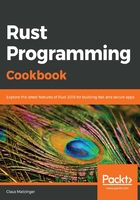
Conventions used
There are a number of text conventions used throughout this book.
CodeInText: Indicates code words in text, database table names, folder names, filenames, file extensions, pathnames, dummy URLs, user input, and Twitter handles. Here is an example: "Mount the downloaded WebStorm-10*.dmg disk image file as another disk in your system."
A block of code is set as follows:
macro_rules! strange_patterns {
(The pattern must match precisely) => { "Text" };
(42) => { "Numeric" };
(;<=,<=;) => { "Alpha" };
}
When we wish to draw your attention to a particular part of a code block, the relevant lines or items are set in bold:
#[test]
#[should_panic]
fn test_failing_make_fn() {
make_fn!(fail, {assert!(false)});
fail();
}
Any command-line input or output is written as follows:
$ cargo run
Bold: Indicates a new term, an important word, or words that you see on screen. For example, words in menus or dialog boxes appear in the text like this. Here is an example: "Select System info from the Administration panel."